Leadership in Business Report: Organizational Change and Leadership
VerifiedAdded on 2020/04/29
|26
|7161
|198
Report
AI Summary
This report delves into the critical role of leadership in navigating the dynamic landscape of modern business. It explores the imperative for organizational changes, driven by factors such as globalization, technological advancements, and evolving consumer demands. The report examines the reasons behind the need for such changes, including the need to adapt to a competitive global market, identify new opportunities, and respond to internal and external pressures. It then categorizes different types of organizational changes, including business process re-engineering, incremental changes, and technological changes. The report also investigates the causes of leadership failures in commercial organizations, providing case studies like Satyam Computers and Alibaba to illustrate leadership successes and failures. Overall, the report emphasizes the importance of proactive change management and effective leadership in ensuring business competitiveness and long-term success.
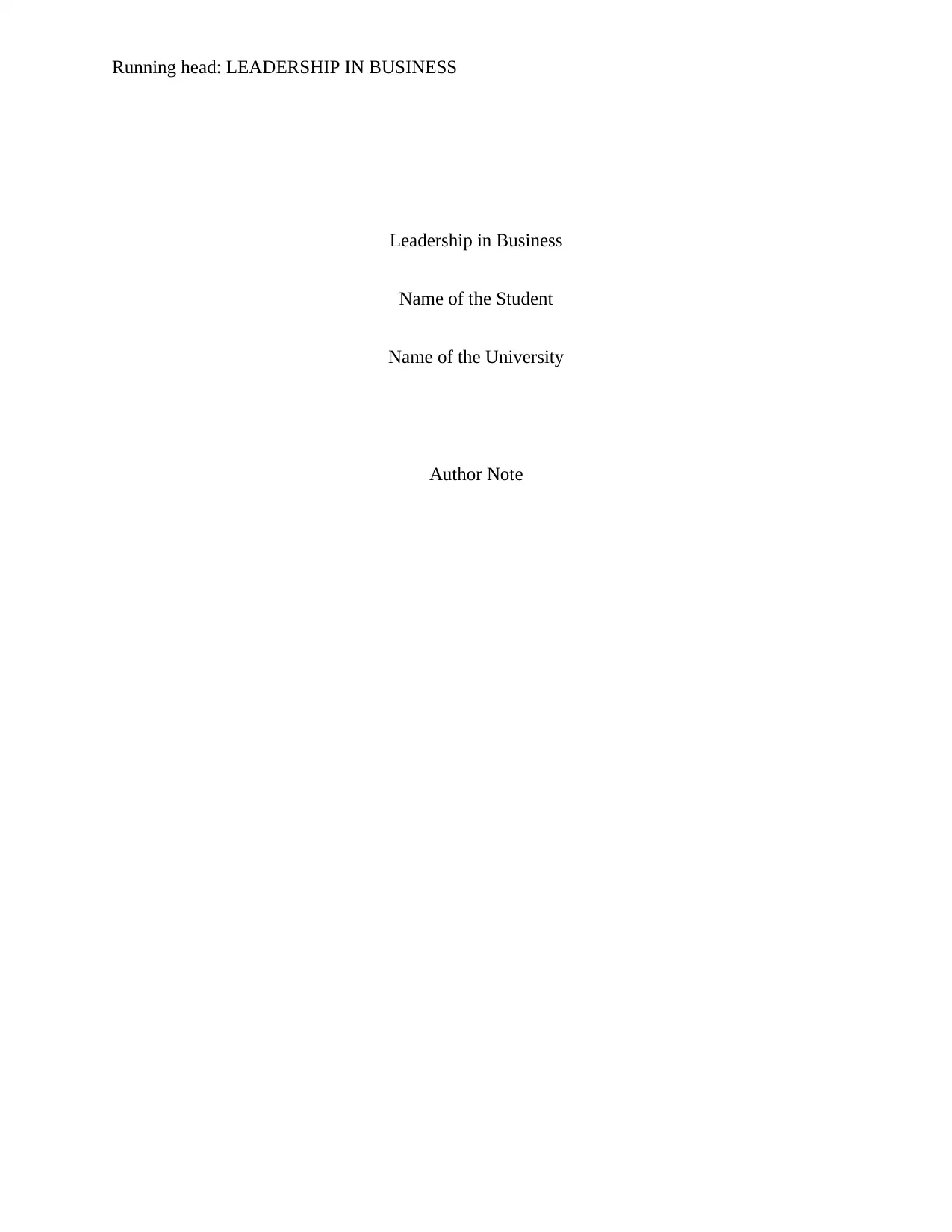
Running head: LEADERSHIP IN BUSINESS
Leadership in Business
Name of the Student
Name of the University
Author Note
Leadership in Business
Name of the Student
Name of the University
Author Note
Paraphrase This Document
Need a fresh take? Get an instant paraphrase of this document with our AI Paraphraser
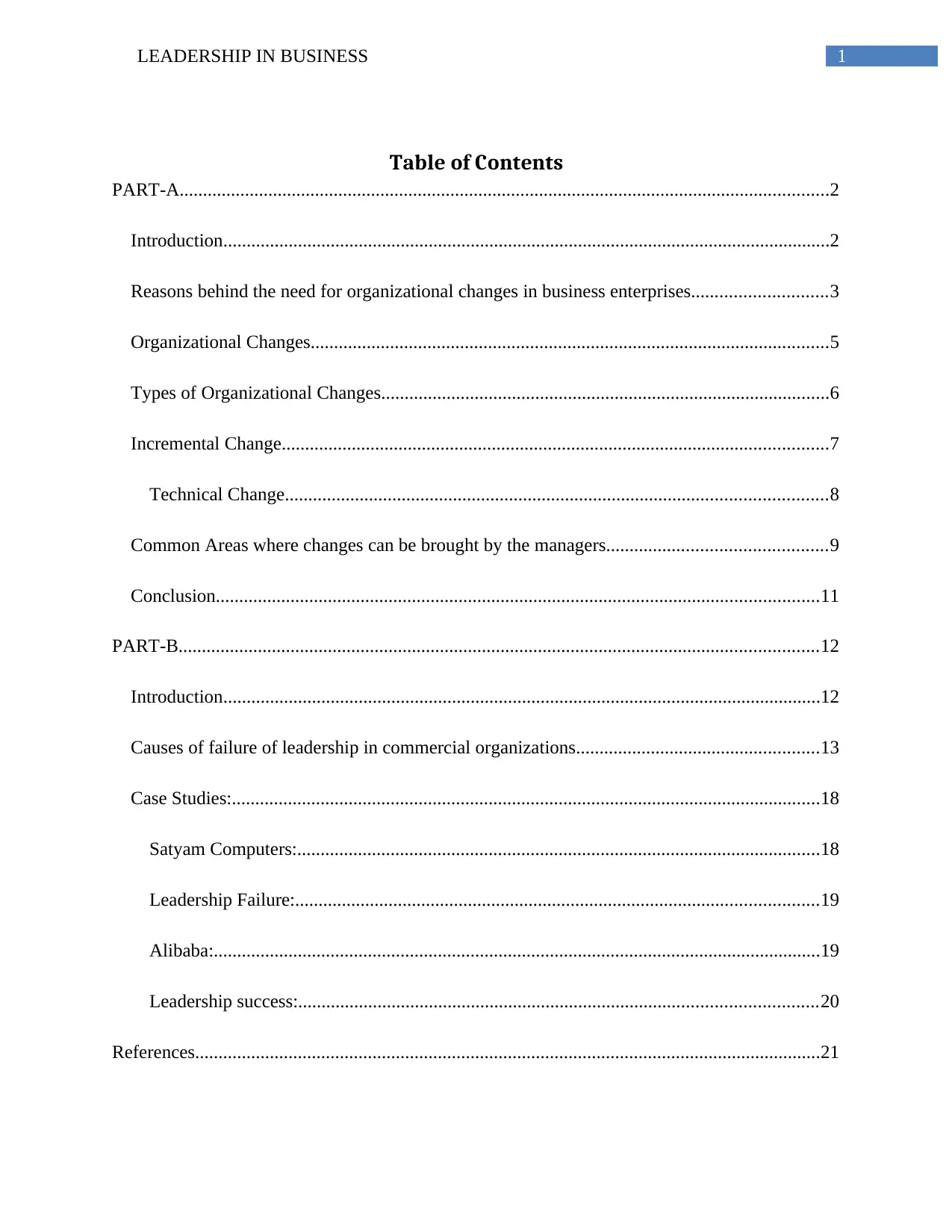
1LEADERSHIP IN BUSINESS
Table of Contents
PART-A...........................................................................................................................................2
Introduction..................................................................................................................................2
Reasons behind the need for organizational changes in business enterprises.............................3
Organizational Changes...............................................................................................................5
Types of Organizational Changes................................................................................................6
Incremental Change.....................................................................................................................7
Technical Change....................................................................................................................8
Common Areas where changes can be brought by the managers...............................................9
Conclusion.................................................................................................................................11
PART-B.........................................................................................................................................12
Introduction................................................................................................................................12
Causes of failure of leadership in commercial organizations....................................................13
Case Studies:..............................................................................................................................18
Satyam Computers:................................................................................................................18
Leadership Failure:................................................................................................................19
Alibaba:..................................................................................................................................19
Leadership success:...............................................................................................................20
References......................................................................................................................................21
Table of Contents
PART-A...........................................................................................................................................2
Introduction..................................................................................................................................2
Reasons behind the need for organizational changes in business enterprises.............................3
Organizational Changes...............................................................................................................5
Types of Organizational Changes................................................................................................6
Incremental Change.....................................................................................................................7
Technical Change....................................................................................................................8
Common Areas where changes can be brought by the managers...............................................9
Conclusion.................................................................................................................................11
PART-B.........................................................................................................................................12
Introduction................................................................................................................................12
Causes of failure of leadership in commercial organizations....................................................13
Case Studies:..............................................................................................................................18
Satyam Computers:................................................................................................................18
Leadership Failure:................................................................................................................19
Alibaba:..................................................................................................................................19
Leadership success:...............................................................................................................20
References......................................................................................................................................21
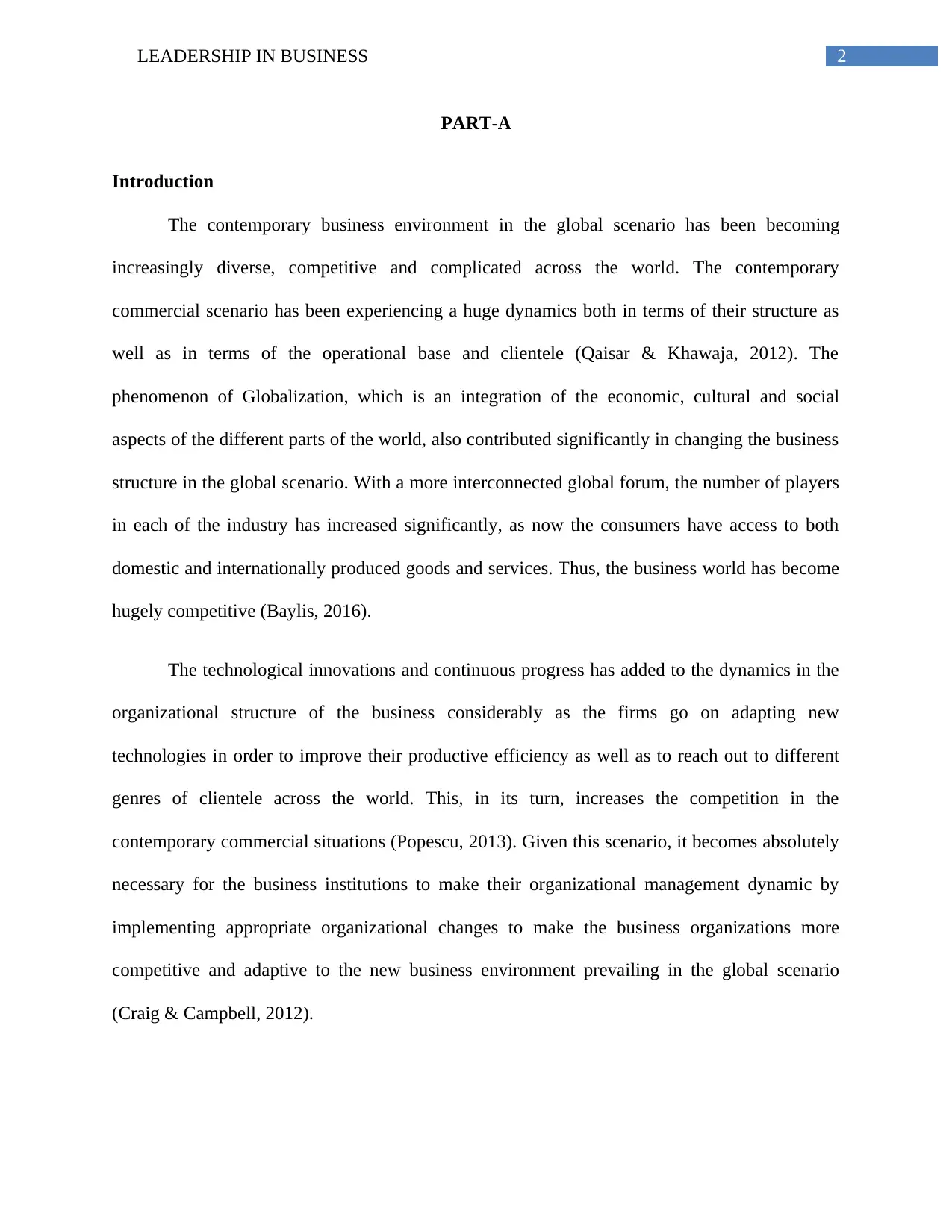
2LEADERSHIP IN BUSINESS
PART-A
Introduction
The contemporary business environment in the global scenario has been becoming
increasingly diverse, competitive and complicated across the world. The contemporary
commercial scenario has been experiencing a huge dynamics both in terms of their structure as
well as in terms of the operational base and clientele (Qaisar & Khawaja, 2012). The
phenomenon of Globalization, which is an integration of the economic, cultural and social
aspects of the different parts of the world, also contributed significantly in changing the business
structure in the global scenario. With a more interconnected global forum, the number of players
in each of the industry has increased significantly, as now the consumers have access to both
domestic and internationally produced goods and services. Thus, the business world has become
hugely competitive (Baylis, 2016).
The technological innovations and continuous progress has added to the dynamics in the
organizational structure of the business considerably as the firms go on adapting new
technologies in order to improve their productive efficiency as well as to reach out to different
genres of clientele across the world. This, in its turn, increases the competition in the
contemporary commercial situations (Popescu, 2013). Given this scenario, it becomes absolutely
necessary for the business institutions to make their organizational management dynamic by
implementing appropriate organizational changes to make the business organizations more
competitive and adaptive to the new business environment prevailing in the global scenario
(Craig & Campbell, 2012).
PART-A
Introduction
The contemporary business environment in the global scenario has been becoming
increasingly diverse, competitive and complicated across the world. The contemporary
commercial scenario has been experiencing a huge dynamics both in terms of their structure as
well as in terms of the operational base and clientele (Qaisar & Khawaja, 2012). The
phenomenon of Globalization, which is an integration of the economic, cultural and social
aspects of the different parts of the world, also contributed significantly in changing the business
structure in the global scenario. With a more interconnected global forum, the number of players
in each of the industry has increased significantly, as now the consumers have access to both
domestic and internationally produced goods and services. Thus, the business world has become
hugely competitive (Baylis, 2016).
The technological innovations and continuous progress has added to the dynamics in the
organizational structure of the business considerably as the firms go on adapting new
technologies in order to improve their productive efficiency as well as to reach out to different
genres of clientele across the world. This, in its turn, increases the competition in the
contemporary commercial situations (Popescu, 2013). Given this scenario, it becomes absolutely
necessary for the business institutions to make their organizational management dynamic by
implementing appropriate organizational changes to make the business organizations more
competitive and adaptive to the new business environment prevailing in the global scenario
(Craig & Campbell, 2012).
⊘ This is a preview!⊘
Do you want full access?
Subscribe today to unlock all pages.

Trusted by 1+ million students worldwide
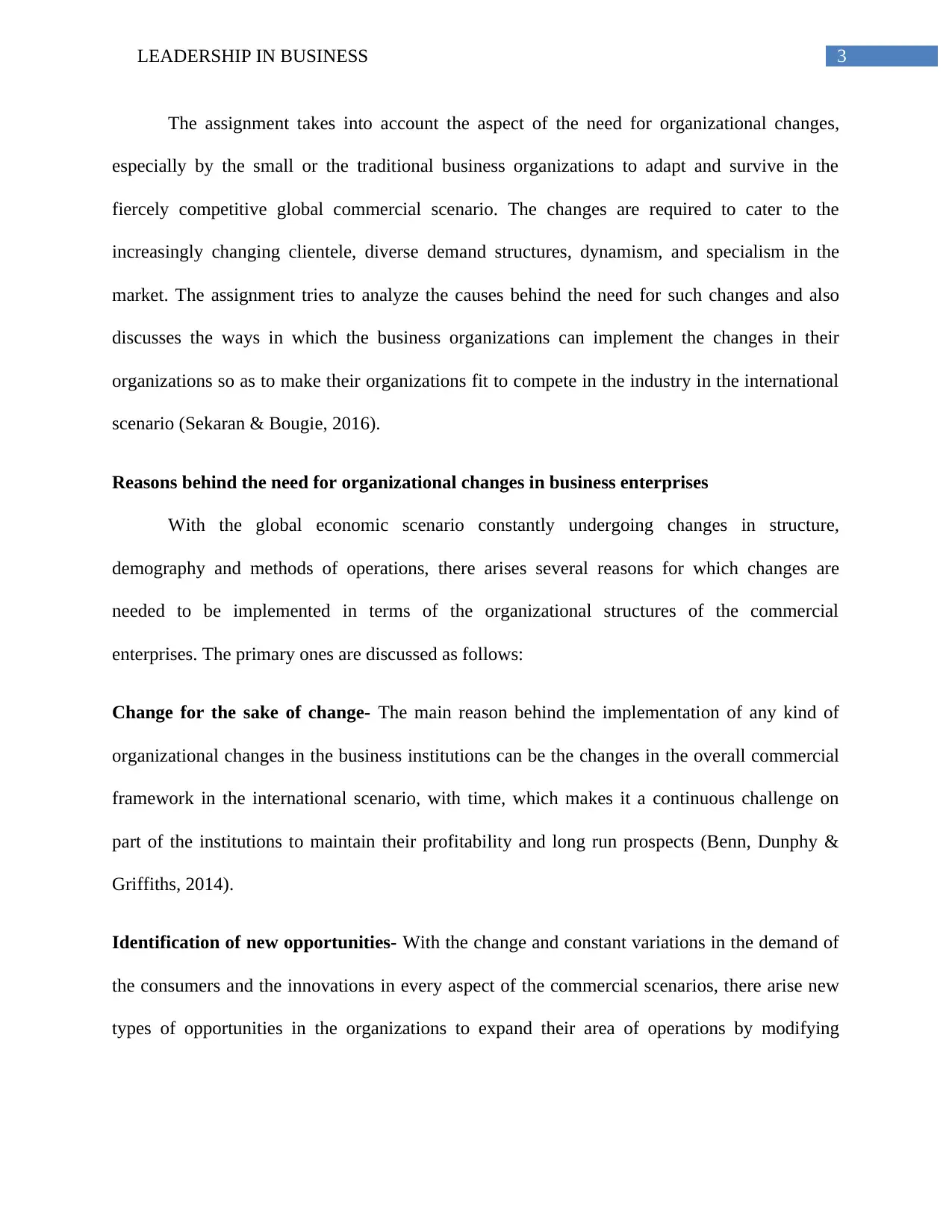
3LEADERSHIP IN BUSINESS
The assignment takes into account the aspect of the need for organizational changes,
especially by the small or the traditional business organizations to adapt and survive in the
fiercely competitive global commercial scenario. The changes are required to cater to the
increasingly changing clientele, diverse demand structures, dynamism, and specialism in the
market. The assignment tries to analyze the causes behind the need for such changes and also
discusses the ways in which the business organizations can implement the changes in their
organizations so as to make their organizations fit to compete in the industry in the international
scenario (Sekaran & Bougie, 2016).
Reasons behind the need for organizational changes in business enterprises
With the global economic scenario constantly undergoing changes in structure,
demography and methods of operations, there arises several reasons for which changes are
needed to be implemented in terms of the organizational structures of the commercial
enterprises. The primary ones are discussed as follows:
Change for the sake of change- The main reason behind the implementation of any kind of
organizational changes in the business institutions can be the changes in the overall commercial
framework in the international scenario, with time, which makes it a continuous challenge on
part of the institutions to maintain their profitability and long run prospects (Benn, Dunphy &
Griffiths, 2014).
Identification of new opportunities- With the change and constant variations in the demand of
the consumers and the innovations in every aspect of the commercial scenarios, there arise new
types of opportunities in the organizations to expand their area of operations by modifying
The assignment takes into account the aspect of the need for organizational changes,
especially by the small or the traditional business organizations to adapt and survive in the
fiercely competitive global commercial scenario. The changes are required to cater to the
increasingly changing clientele, diverse demand structures, dynamism, and specialism in the
market. The assignment tries to analyze the causes behind the need for such changes and also
discusses the ways in which the business organizations can implement the changes in their
organizations so as to make their organizations fit to compete in the industry in the international
scenario (Sekaran & Bougie, 2016).
Reasons behind the need for organizational changes in business enterprises
With the global economic scenario constantly undergoing changes in structure,
demography and methods of operations, there arises several reasons for which changes are
needed to be implemented in terms of the organizational structures of the commercial
enterprises. The primary ones are discussed as follows:
Change for the sake of change- The main reason behind the implementation of any kind of
organizational changes in the business institutions can be the changes in the overall commercial
framework in the international scenario, with time, which makes it a continuous challenge on
part of the institutions to maintain their profitability and long run prospects (Benn, Dunphy &
Griffiths, 2014).
Identification of new opportunities- With the change and constant variations in the demand of
the consumers and the innovations in every aspect of the commercial scenarios, there arise new
types of opportunities in the organizations to expand their area of operations by modifying
Paraphrase This Document
Need a fresh take? Get an instant paraphrase of this document with our AI Paraphraser
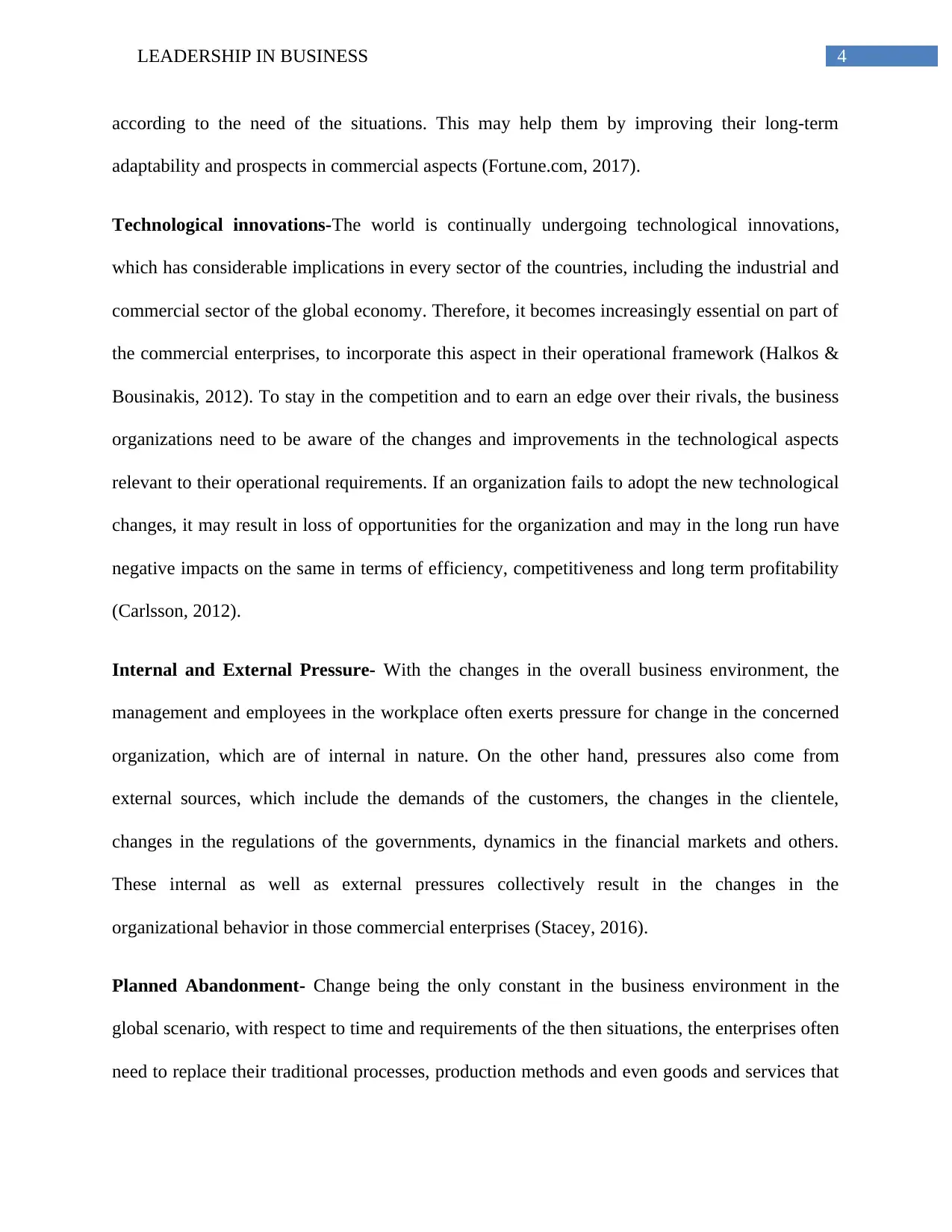
4LEADERSHIP IN BUSINESS
according to the need of the situations. This may help them by improving their long-term
adaptability and prospects in commercial aspects (Fortune.com, 2017).
Technological innovations-The world is continually undergoing technological innovations,
which has considerable implications in every sector of the countries, including the industrial and
commercial sector of the global economy. Therefore, it becomes increasingly essential on part of
the commercial enterprises, to incorporate this aspect in their operational framework (Halkos &
Bousinakis, 2012). To stay in the competition and to earn an edge over their rivals, the business
organizations need to be aware of the changes and improvements in the technological aspects
relevant to their operational requirements. If an organization fails to adopt the new technological
changes, it may result in loss of opportunities for the organization and may in the long run have
negative impacts on the same in terms of efficiency, competitiveness and long term profitability
(Carlsson, 2012).
Internal and External Pressure- With the changes in the overall business environment, the
management and employees in the workplace often exerts pressure for change in the concerned
organization, which are of internal in nature. On the other hand, pressures also come from
external sources, which include the demands of the customers, the changes in the clientele,
changes in the regulations of the governments, dynamics in the financial markets and others.
These internal as well as external pressures collectively result in the changes in the
organizational behavior in those commercial enterprises (Stacey, 2016).
Planned Abandonment- Change being the only constant in the business environment in the
global scenario, with respect to time and requirements of the then situations, the enterprises often
need to replace their traditional processes, production methods and even goods and services that
according to the need of the situations. This may help them by improving their long-term
adaptability and prospects in commercial aspects (Fortune.com, 2017).
Technological innovations-The world is continually undergoing technological innovations,
which has considerable implications in every sector of the countries, including the industrial and
commercial sector of the global economy. Therefore, it becomes increasingly essential on part of
the commercial enterprises, to incorporate this aspect in their operational framework (Halkos &
Bousinakis, 2012). To stay in the competition and to earn an edge over their rivals, the business
organizations need to be aware of the changes and improvements in the technological aspects
relevant to their operational requirements. If an organization fails to adopt the new technological
changes, it may result in loss of opportunities for the organization and may in the long run have
negative impacts on the same in terms of efficiency, competitiveness and long term profitability
(Carlsson, 2012).
Internal and External Pressure- With the changes in the overall business environment, the
management and employees in the workplace often exerts pressure for change in the concerned
organization, which are of internal in nature. On the other hand, pressures also come from
external sources, which include the demands of the customers, the changes in the clientele,
changes in the regulations of the governments, dynamics in the financial markets and others.
These internal as well as external pressures collectively result in the changes in the
organizational behavior in those commercial enterprises (Stacey, 2016).
Planned Abandonment- Change being the only constant in the business environment in the
global scenario, with respect to time and requirements of the then situations, the enterprises often
need to replace their traditional processes, production methods and even goods and services that
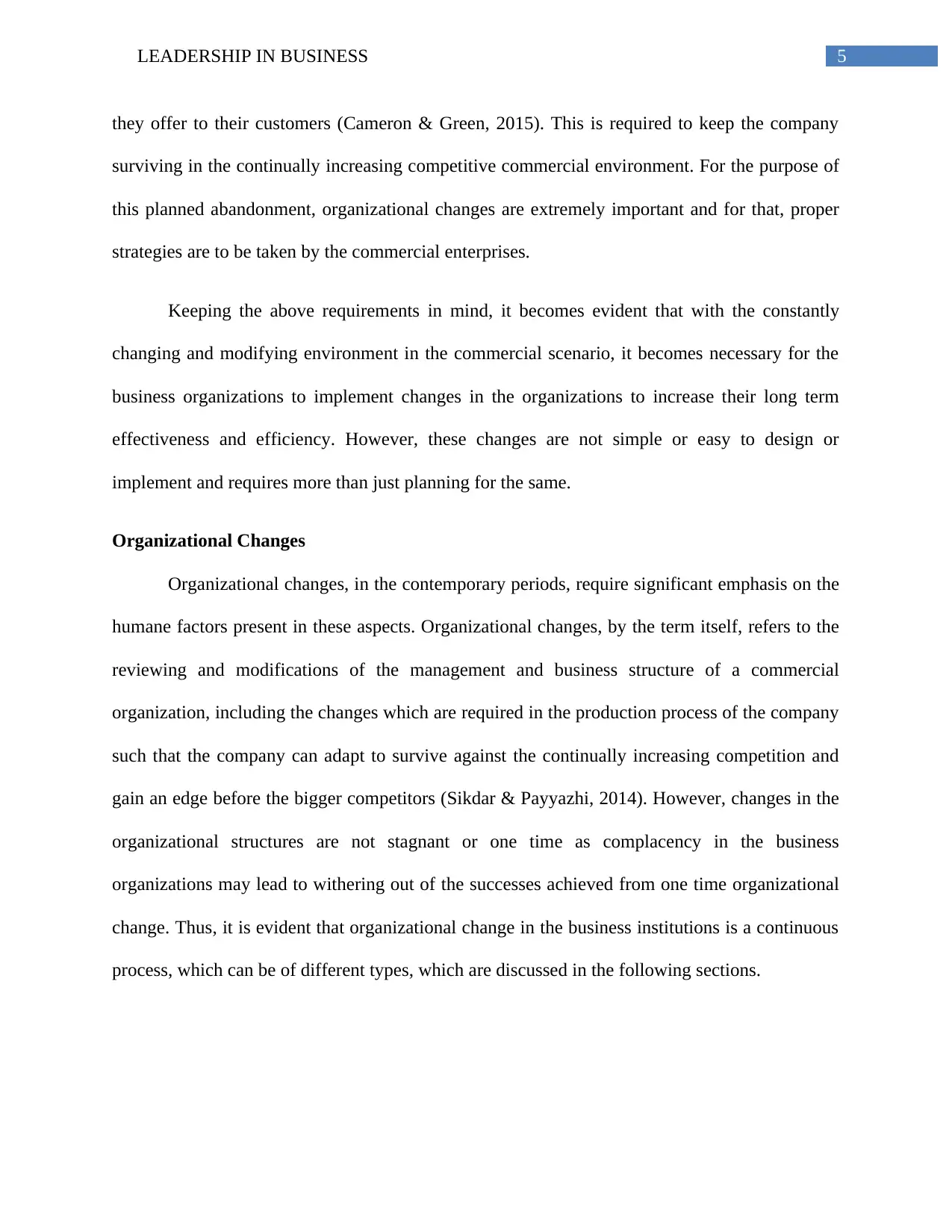
5LEADERSHIP IN BUSINESS
they offer to their customers (Cameron & Green, 2015). This is required to keep the company
surviving in the continually increasing competitive commercial environment. For the purpose of
this planned abandonment, organizational changes are extremely important and for that, proper
strategies are to be taken by the commercial enterprises.
Keeping the above requirements in mind, it becomes evident that with the constantly
changing and modifying environment in the commercial scenario, it becomes necessary for the
business organizations to implement changes in the organizations to increase their long term
effectiveness and efficiency. However, these changes are not simple or easy to design or
implement and requires more than just planning for the same.
Organizational Changes
Organizational changes, in the contemporary periods, require significant emphasis on the
humane factors present in these aspects. Organizational changes, by the term itself, refers to the
reviewing and modifications of the management and business structure of a commercial
organization, including the changes which are required in the production process of the company
such that the company can adapt to survive against the continually increasing competition and
gain an edge before the bigger competitors (Sikdar & Payyazhi, 2014). However, changes in the
organizational structures are not stagnant or one time as complacency in the business
organizations may lead to withering out of the successes achieved from one time organizational
change. Thus, it is evident that organizational change in the business institutions is a continuous
process, which can be of different types, which are discussed in the following sections.
they offer to their customers (Cameron & Green, 2015). This is required to keep the company
surviving in the continually increasing competitive commercial environment. For the purpose of
this planned abandonment, organizational changes are extremely important and for that, proper
strategies are to be taken by the commercial enterprises.
Keeping the above requirements in mind, it becomes evident that with the constantly
changing and modifying environment in the commercial scenario, it becomes necessary for the
business organizations to implement changes in the organizations to increase their long term
effectiveness and efficiency. However, these changes are not simple or easy to design or
implement and requires more than just planning for the same.
Organizational Changes
Organizational changes, in the contemporary periods, require significant emphasis on the
humane factors present in these aspects. Organizational changes, by the term itself, refers to the
reviewing and modifications of the management and business structure of a commercial
organization, including the changes which are required in the production process of the company
such that the company can adapt to survive against the continually increasing competition and
gain an edge before the bigger competitors (Sikdar & Payyazhi, 2014). However, changes in the
organizational structures are not stagnant or one time as complacency in the business
organizations may lead to withering out of the successes achieved from one time organizational
change. Thus, it is evident that organizational change in the business institutions is a continuous
process, which can be of different types, which are discussed in the following sections.
⊘ This is a preview!⊘
Do you want full access?
Subscribe today to unlock all pages.

Trusted by 1+ million students worldwide
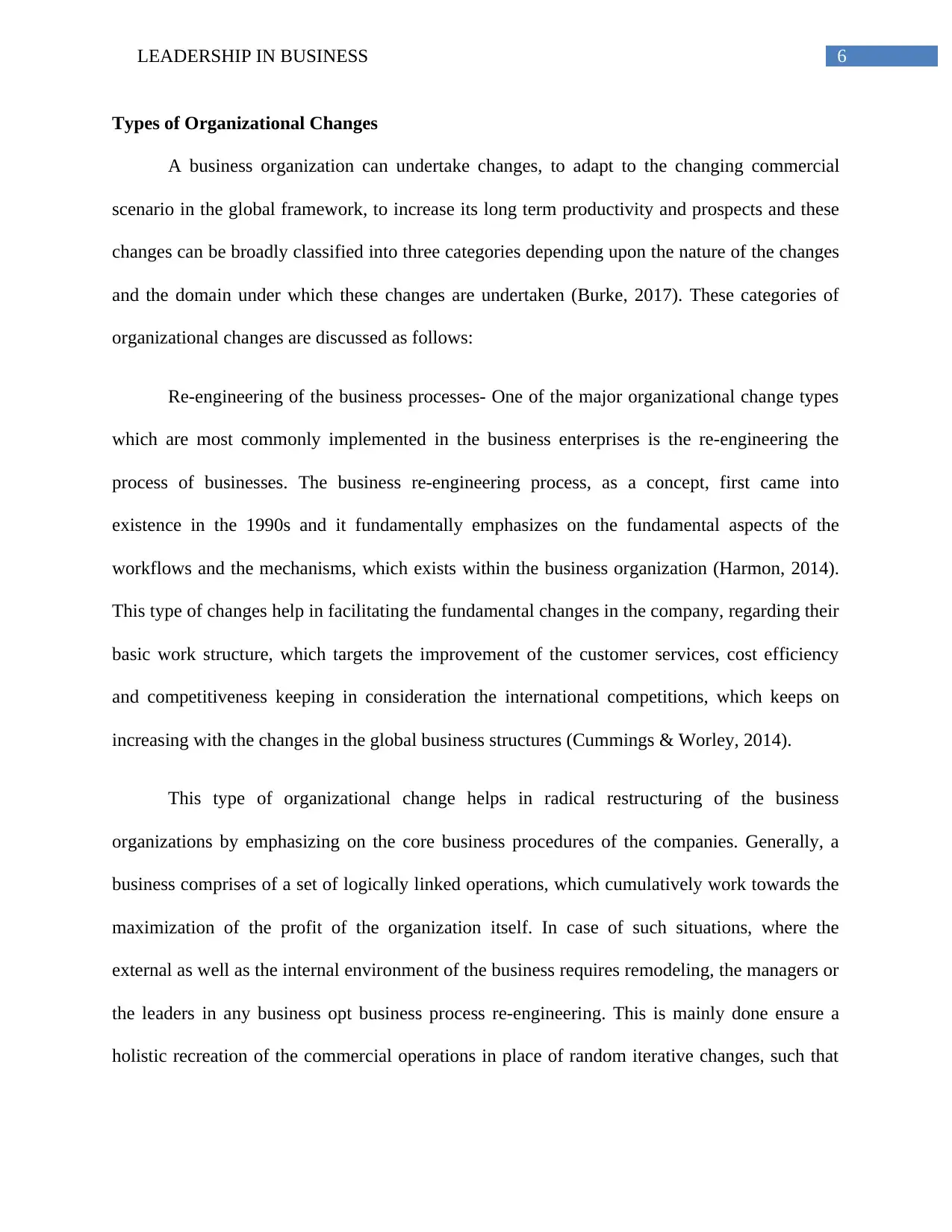
6LEADERSHIP IN BUSINESS
Types of Organizational Changes
A business organization can undertake changes, to adapt to the changing commercial
scenario in the global framework, to increase its long term productivity and prospects and these
changes can be broadly classified into three categories depending upon the nature of the changes
and the domain under which these changes are undertaken (Burke, 2017). These categories of
organizational changes are discussed as follows:
Re-engineering of the business processes- One of the major organizational change types
which are most commonly implemented in the business enterprises is the re-engineering the
process of businesses. The business re-engineering process, as a concept, first came into
existence in the 1990s and it fundamentally emphasizes on the fundamental aspects of the
workflows and the mechanisms, which exists within the business organization (Harmon, 2014).
This type of changes help in facilitating the fundamental changes in the company, regarding their
basic work structure, which targets the improvement of the customer services, cost efficiency
and competitiveness keeping in consideration the international competitions, which keeps on
increasing with the changes in the global business structures (Cummings & Worley, 2014).
This type of organizational change helps in radical restructuring of the business
organizations by emphasizing on the core business procedures of the companies. Generally, a
business comprises of a set of logically linked operations, which cumulatively work towards the
maximization of the profit of the organization itself. In case of such situations, where the
external as well as the internal environment of the business requires remodeling, the managers or
the leaders in any business opt business process re-engineering. This is mainly done ensure a
holistic recreation of the commercial operations in place of random iterative changes, such that
Types of Organizational Changes
A business organization can undertake changes, to adapt to the changing commercial
scenario in the global framework, to increase its long term productivity and prospects and these
changes can be broadly classified into three categories depending upon the nature of the changes
and the domain under which these changes are undertaken (Burke, 2017). These categories of
organizational changes are discussed as follows:
Re-engineering of the business processes- One of the major organizational change types
which are most commonly implemented in the business enterprises is the re-engineering the
process of businesses. The business re-engineering process, as a concept, first came into
existence in the 1990s and it fundamentally emphasizes on the fundamental aspects of the
workflows and the mechanisms, which exists within the business organization (Harmon, 2014).
This type of changes help in facilitating the fundamental changes in the company, regarding their
basic work structure, which targets the improvement of the customer services, cost efficiency
and competitiveness keeping in consideration the international competitions, which keeps on
increasing with the changes in the global business structures (Cummings & Worley, 2014).
This type of organizational change helps in radical restructuring of the business
organizations by emphasizing on the core business procedures of the companies. Generally, a
business comprises of a set of logically linked operations, which cumulatively work towards the
maximization of the profit of the organization itself. In case of such situations, where the
external as well as the internal environment of the business requires remodeling, the managers or
the leaders in any business opt business process re-engineering. This is mainly done ensure a
holistic recreation of the commercial operations in place of random iterative changes, such that
Paraphrase This Document
Need a fresh take? Get an instant paraphrase of this document with our AI Paraphraser
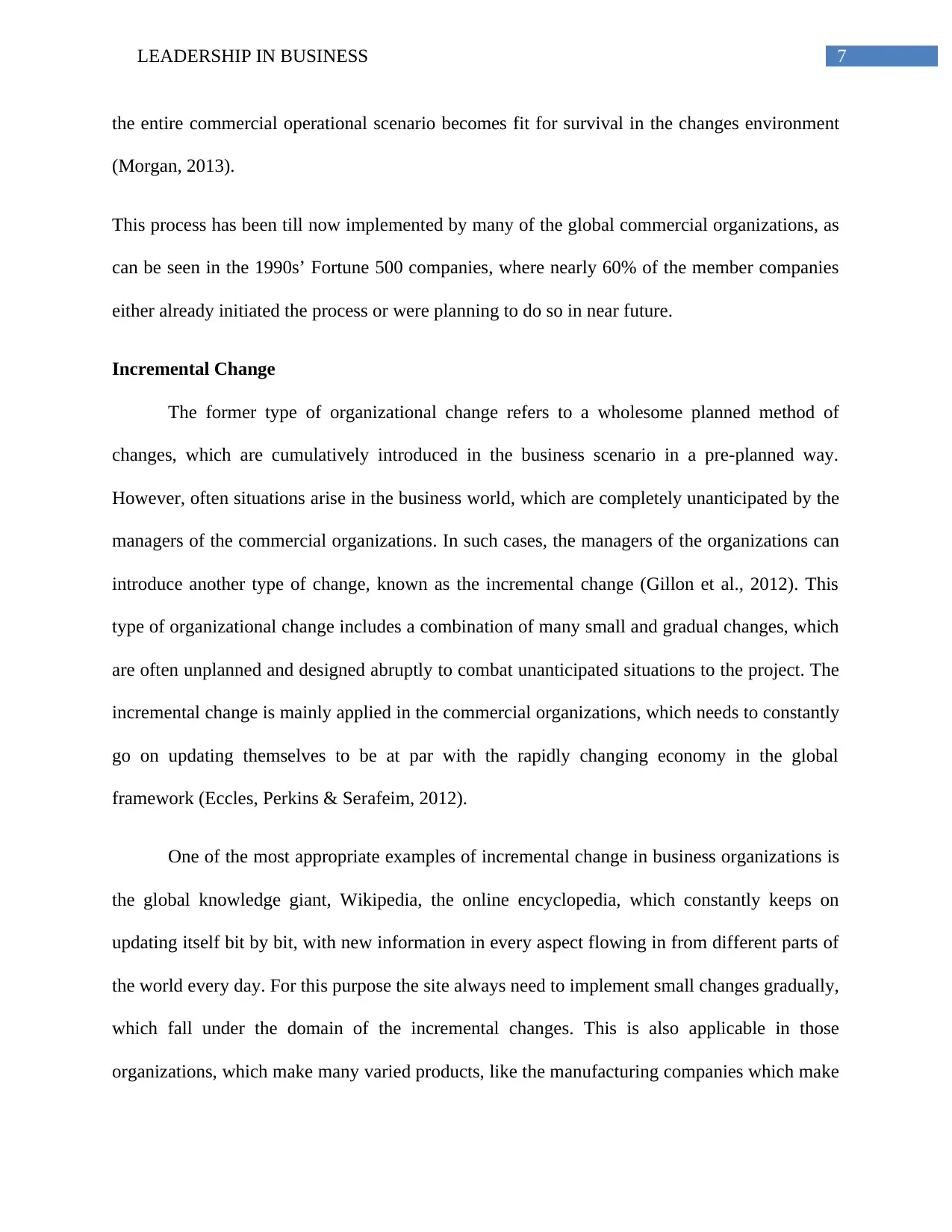
7LEADERSHIP IN BUSINESS
the entire commercial operational scenario becomes fit for survival in the changes environment
(Morgan, 2013).
This process has been till now implemented by many of the global commercial organizations, as
can be seen in the 1990s’ Fortune 500 companies, where nearly 60% of the member companies
either already initiated the process or were planning to do so in near future.
Incremental Change
The former type of organizational change refers to a wholesome planned method of
changes, which are cumulatively introduced in the business scenario in a pre-planned way.
However, often situations arise in the business world, which are completely unanticipated by the
managers of the commercial organizations. In such cases, the managers of the organizations can
introduce another type of change, known as the incremental change (Gillon et al., 2012). This
type of organizational change includes a combination of many small and gradual changes, which
are often unplanned and designed abruptly to combat unanticipated situations to the project. The
incremental change is mainly applied in the commercial organizations, which needs to constantly
go on updating themselves to be at par with the rapidly changing economy in the global
framework (Eccles, Perkins & Serafeim, 2012).
One of the most appropriate examples of incremental change in business organizations is
the global knowledge giant, Wikipedia, the online encyclopedia, which constantly keeps on
updating itself bit by bit, with new information in every aspect flowing in from different parts of
the world every day. For this purpose the site always need to implement small changes gradually,
which fall under the domain of the incremental changes. This is also applicable in those
organizations, which make many varied products, like the manufacturing companies which make
the entire commercial operational scenario becomes fit for survival in the changes environment
(Morgan, 2013).
This process has been till now implemented by many of the global commercial organizations, as
can be seen in the 1990s’ Fortune 500 companies, where nearly 60% of the member companies
either already initiated the process or were planning to do so in near future.
Incremental Change
The former type of organizational change refers to a wholesome planned method of
changes, which are cumulatively introduced in the business scenario in a pre-planned way.
However, often situations arise in the business world, which are completely unanticipated by the
managers of the commercial organizations. In such cases, the managers of the organizations can
introduce another type of change, known as the incremental change (Gillon et al., 2012). This
type of organizational change includes a combination of many small and gradual changes, which
are often unplanned and designed abruptly to combat unanticipated situations to the project. The
incremental change is mainly applied in the commercial organizations, which needs to constantly
go on updating themselves to be at par with the rapidly changing economy in the global
framework (Eccles, Perkins & Serafeim, 2012).
One of the most appropriate examples of incremental change in business organizations is
the global knowledge giant, Wikipedia, the online encyclopedia, which constantly keeps on
updating itself bit by bit, with new information in every aspect flowing in from different parts of
the world every day. For this purpose the site always need to implement small changes gradually,
which fall under the domain of the incremental changes. This is also applicable in those
organizations, which make many varied products, like the manufacturing companies which make
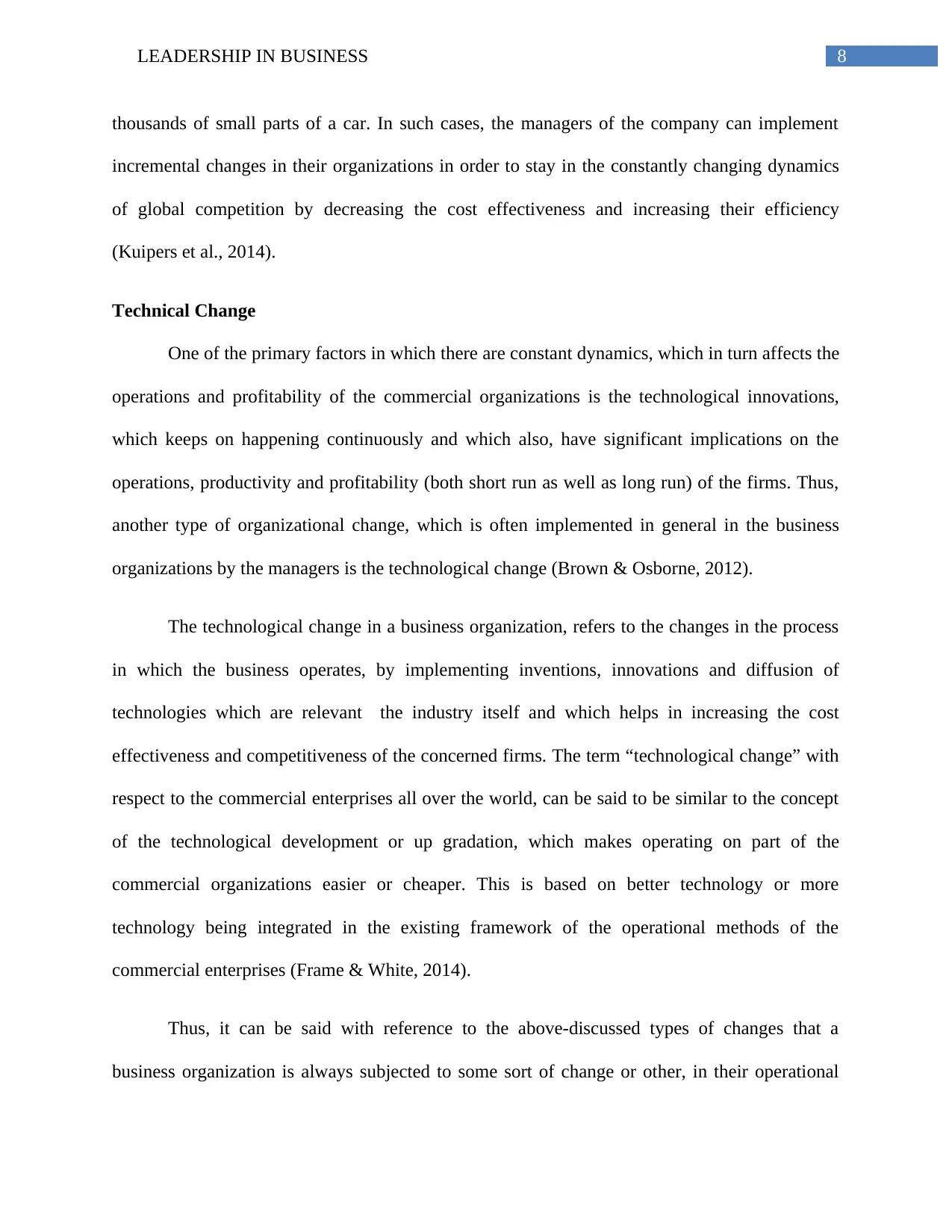
8LEADERSHIP IN BUSINESS
thousands of small parts of a car. In such cases, the managers of the company can implement
incremental changes in their organizations in order to stay in the constantly changing dynamics
of global competition by decreasing the cost effectiveness and increasing their efficiency
(Kuipers et al., 2014).
Technical Change
One of the primary factors in which there are constant dynamics, which in turn affects the
operations and profitability of the commercial organizations is the technological innovations,
which keeps on happening continuously and which also, have significant implications on the
operations, productivity and profitability (both short run as well as long run) of the firms. Thus,
another type of organizational change, which is often implemented in general in the business
organizations by the managers is the technological change (Brown & Osborne, 2012).
The technological change in a business organization, refers to the changes in the process
in which the business operates, by implementing inventions, innovations and diffusion of
technologies which are relevant the industry itself and which helps in increasing the cost
effectiveness and competitiveness of the concerned firms. The term “technological change” with
respect to the commercial enterprises all over the world, can be said to be similar to the concept
of the technological development or up gradation, which makes operating on part of the
commercial organizations easier or cheaper. This is based on better technology or more
technology being integrated in the existing framework of the operational methods of the
commercial enterprises (Frame & White, 2014).
Thus, it can be said with reference to the above-discussed types of changes that a
business organization is always subjected to some sort of change or other, in their operational
thousands of small parts of a car. In such cases, the managers of the company can implement
incremental changes in their organizations in order to stay in the constantly changing dynamics
of global competition by decreasing the cost effectiveness and increasing their efficiency
(Kuipers et al., 2014).
Technical Change
One of the primary factors in which there are constant dynamics, which in turn affects the
operations and profitability of the commercial organizations is the technological innovations,
which keeps on happening continuously and which also, have significant implications on the
operations, productivity and profitability (both short run as well as long run) of the firms. Thus,
another type of organizational change, which is often implemented in general in the business
organizations by the managers is the technological change (Brown & Osborne, 2012).
The technological change in a business organization, refers to the changes in the process
in which the business operates, by implementing inventions, innovations and diffusion of
technologies which are relevant the industry itself and which helps in increasing the cost
effectiveness and competitiveness of the concerned firms. The term “technological change” with
respect to the commercial enterprises all over the world, can be said to be similar to the concept
of the technological development or up gradation, which makes operating on part of the
commercial organizations easier or cheaper. This is based on better technology or more
technology being integrated in the existing framework of the operational methods of the
commercial enterprises (Frame & White, 2014).
Thus, it can be said with reference to the above-discussed types of changes that a
business organization is always subjected to some sort of change or other, in their operational
⊘ This is a preview!⊘
Do you want full access?
Subscribe today to unlock all pages.

Trusted by 1+ million students worldwide
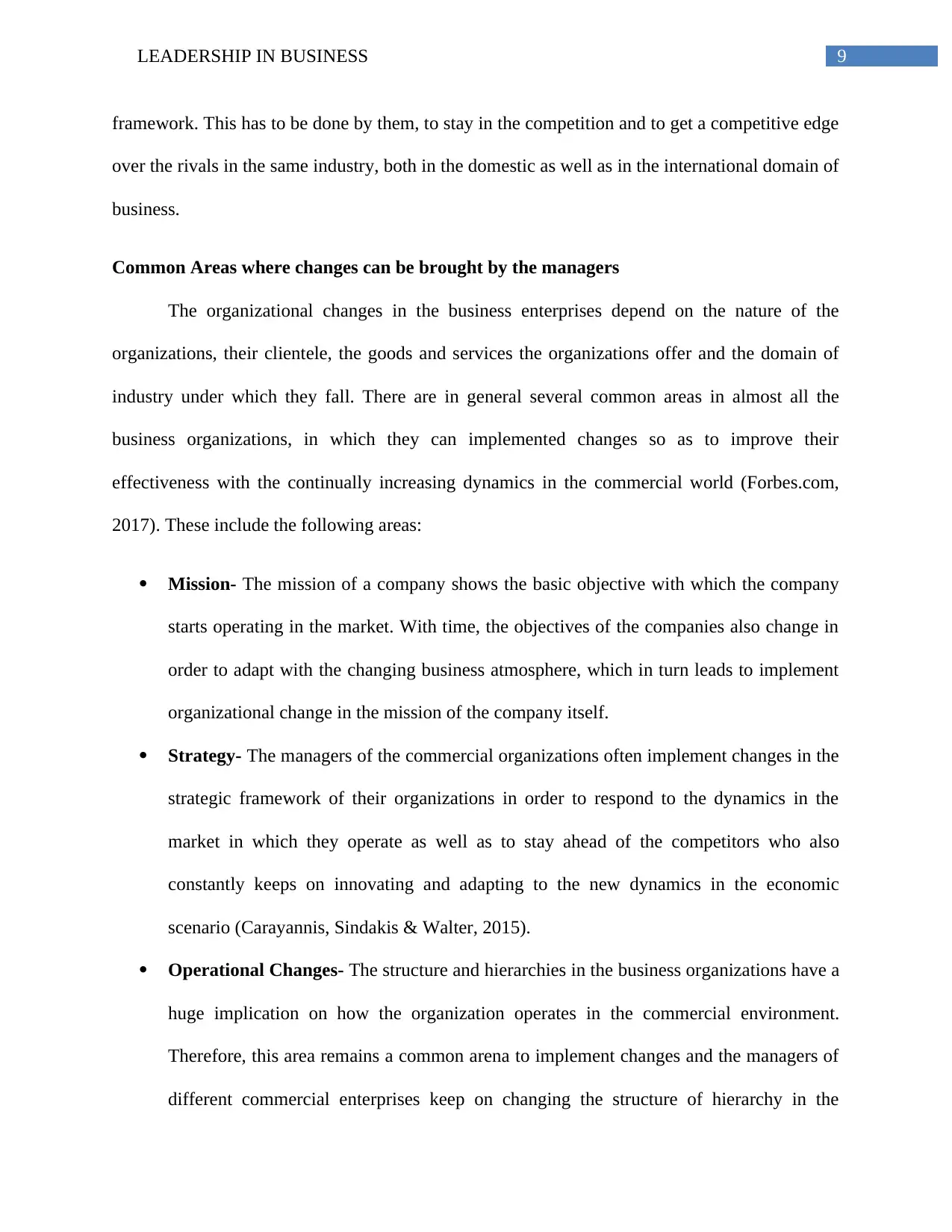
9LEADERSHIP IN BUSINESS
framework. This has to be done by them, to stay in the competition and to get a competitive edge
over the rivals in the same industry, both in the domestic as well as in the international domain of
business.
Common Areas where changes can be brought by the managers
The organizational changes in the business enterprises depend on the nature of the
organizations, their clientele, the goods and services the organizations offer and the domain of
industry under which they fall. There are in general several common areas in almost all the
business organizations, in which they can implemented changes so as to improve their
effectiveness with the continually increasing dynamics in the commercial world (Forbes.com,
2017). These include the following areas:
Mission- The mission of a company shows the basic objective with which the company
starts operating in the market. With time, the objectives of the companies also change in
order to adapt with the changing business atmosphere, which in turn leads to implement
organizational change in the mission of the company itself.
Strategy- The managers of the commercial organizations often implement changes in the
strategic framework of their organizations in order to respond to the dynamics in the
market in which they operate as well as to stay ahead of the competitors who also
constantly keeps on innovating and adapting to the new dynamics in the economic
scenario (Carayannis, Sindakis & Walter, 2015).
Operational Changes- The structure and hierarchies in the business organizations have a
huge implication on how the organization operates in the commercial environment.
Therefore, this area remains a common arena to implement changes and the managers of
different commercial enterprises keep on changing the structure of hierarchy in the
framework. This has to be done by them, to stay in the competition and to get a competitive edge
over the rivals in the same industry, both in the domestic as well as in the international domain of
business.
Common Areas where changes can be brought by the managers
The organizational changes in the business enterprises depend on the nature of the
organizations, their clientele, the goods and services the organizations offer and the domain of
industry under which they fall. There are in general several common areas in almost all the
business organizations, in which they can implemented changes so as to improve their
effectiveness with the continually increasing dynamics in the commercial world (Forbes.com,
2017). These include the following areas:
Mission- The mission of a company shows the basic objective with which the company
starts operating in the market. With time, the objectives of the companies also change in
order to adapt with the changing business atmosphere, which in turn leads to implement
organizational change in the mission of the company itself.
Strategy- The managers of the commercial organizations often implement changes in the
strategic framework of their organizations in order to respond to the dynamics in the
market in which they operate as well as to stay ahead of the competitors who also
constantly keeps on innovating and adapting to the new dynamics in the economic
scenario (Carayannis, Sindakis & Walter, 2015).
Operational Changes- The structure and hierarchies in the business organizations have a
huge implication on how the organization operates in the commercial environment.
Therefore, this area remains a common arena to implement changes and the managers of
different commercial enterprises keep on changing the structure of hierarchy in the
Paraphrase This Document
Need a fresh take? Get an instant paraphrase of this document with our AI Paraphraser
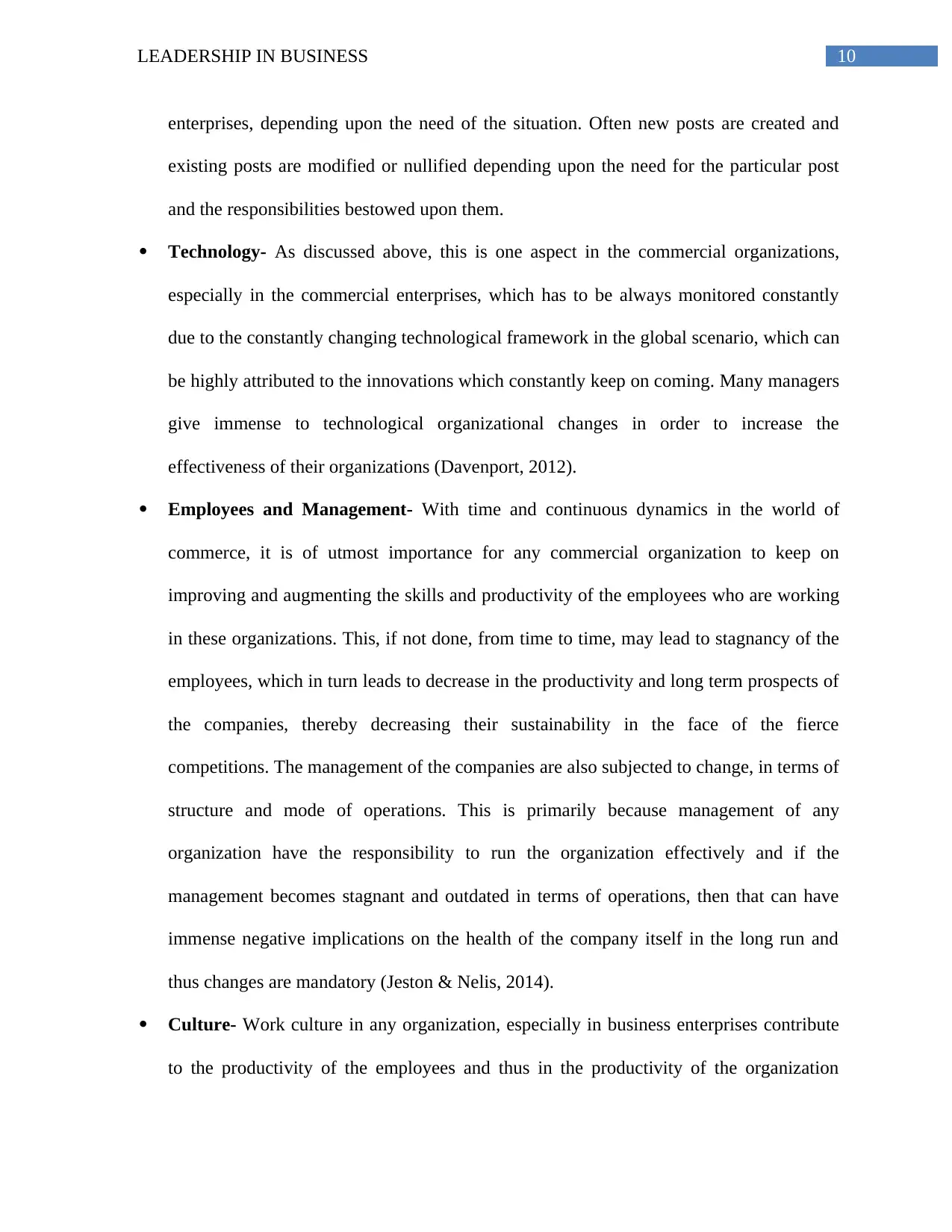
10LEADERSHIP IN BUSINESS
enterprises, depending upon the need of the situation. Often new posts are created and
existing posts are modified or nullified depending upon the need for the particular post
and the responsibilities bestowed upon them.
Technology- As discussed above, this is one aspect in the commercial organizations,
especially in the commercial enterprises, which has to be always monitored constantly
due to the constantly changing technological framework in the global scenario, which can
be highly attributed to the innovations which constantly keep on coming. Many managers
give immense to technological organizational changes in order to increase the
effectiveness of their organizations (Davenport, 2012).
Employees and Management- With time and continuous dynamics in the world of
commerce, it is of utmost importance for any commercial organization to keep on
improving and augmenting the skills and productivity of the employees who are working
in these organizations. This, if not done, from time to time, may lead to stagnancy of the
employees, which in turn leads to decrease in the productivity and long term prospects of
the companies, thereby decreasing their sustainability in the face of the fierce
competitions. The management of the companies are also subjected to change, in terms of
structure and mode of operations. This is primarily because management of any
organization have the responsibility to run the organization effectively and if the
management becomes stagnant and outdated in terms of operations, then that can have
immense negative implications on the health of the company itself in the long run and
thus changes are mandatory (Jeston & Nelis, 2014).
Culture- Work culture in any organization, especially in business enterprises contribute
to the productivity of the employees and thus in the productivity of the organization
enterprises, depending upon the need of the situation. Often new posts are created and
existing posts are modified or nullified depending upon the need for the particular post
and the responsibilities bestowed upon them.
Technology- As discussed above, this is one aspect in the commercial organizations,
especially in the commercial enterprises, which has to be always monitored constantly
due to the constantly changing technological framework in the global scenario, which can
be highly attributed to the innovations which constantly keep on coming. Many managers
give immense to technological organizational changes in order to increase the
effectiveness of their organizations (Davenport, 2012).
Employees and Management- With time and continuous dynamics in the world of
commerce, it is of utmost importance for any commercial organization to keep on
improving and augmenting the skills and productivity of the employees who are working
in these organizations. This, if not done, from time to time, may lead to stagnancy of the
employees, which in turn leads to decrease in the productivity and long term prospects of
the companies, thereby decreasing their sustainability in the face of the fierce
competitions. The management of the companies are also subjected to change, in terms of
structure and mode of operations. This is primarily because management of any
organization have the responsibility to run the organization effectively and if the
management becomes stagnant and outdated in terms of operations, then that can have
immense negative implications on the health of the company itself in the long run and
thus changes are mandatory (Jeston & Nelis, 2014).
Culture- Work culture in any organization, especially in business enterprises contribute
to the productivity of the employees and thus in the productivity of the organization
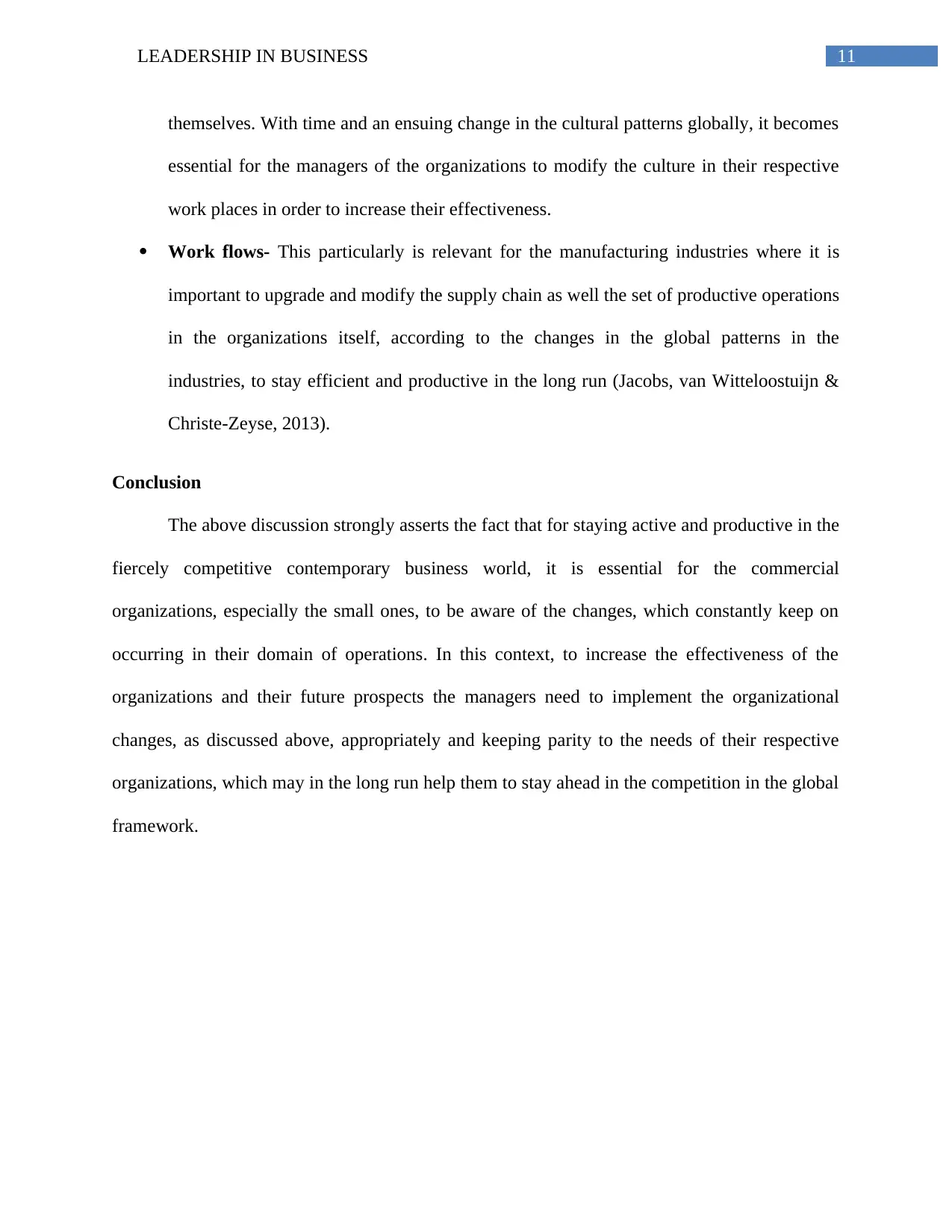
11LEADERSHIP IN BUSINESS
themselves. With time and an ensuing change in the cultural patterns globally, it becomes
essential for the managers of the organizations to modify the culture in their respective
work places in order to increase their effectiveness.
Work flows- This particularly is relevant for the manufacturing industries where it is
important to upgrade and modify the supply chain as well the set of productive operations
in the organizations itself, according to the changes in the global patterns in the
industries, to stay efficient and productive in the long run (Jacobs, van Witteloostuijn &
Christe-Zeyse, 2013).
Conclusion
The above discussion strongly asserts the fact that for staying active and productive in the
fiercely competitive contemporary business world, it is essential for the commercial
organizations, especially the small ones, to be aware of the changes, which constantly keep on
occurring in their domain of operations. In this context, to increase the effectiveness of the
organizations and their future prospects the managers need to implement the organizational
changes, as discussed above, appropriately and keeping parity to the needs of their respective
organizations, which may in the long run help them to stay ahead in the competition in the global
framework.
themselves. With time and an ensuing change in the cultural patterns globally, it becomes
essential for the managers of the organizations to modify the culture in their respective
work places in order to increase their effectiveness.
Work flows- This particularly is relevant for the manufacturing industries where it is
important to upgrade and modify the supply chain as well the set of productive operations
in the organizations itself, according to the changes in the global patterns in the
industries, to stay efficient and productive in the long run (Jacobs, van Witteloostuijn &
Christe-Zeyse, 2013).
Conclusion
The above discussion strongly asserts the fact that for staying active and productive in the
fiercely competitive contemporary business world, it is essential for the commercial
organizations, especially the small ones, to be aware of the changes, which constantly keep on
occurring in their domain of operations. In this context, to increase the effectiveness of the
organizations and their future prospects the managers need to implement the organizational
changes, as discussed above, appropriately and keeping parity to the needs of their respective
organizations, which may in the long run help them to stay ahead in the competition in the global
framework.
⊘ This is a preview!⊘
Do you want full access?
Subscribe today to unlock all pages.

Trusted by 1+ million students worldwide
1 out of 26
Related Documents
Your All-in-One AI-Powered Toolkit for Academic Success.
+13062052269
info@desklib.com
Available 24*7 on WhatsApp / Email
![[object Object]](/_next/static/media/star-bottom.7253800d.svg)
Unlock your academic potential
Copyright © 2020–2025 A2Z Services. All Rights Reserved. Developed and managed by ZUCOL.





